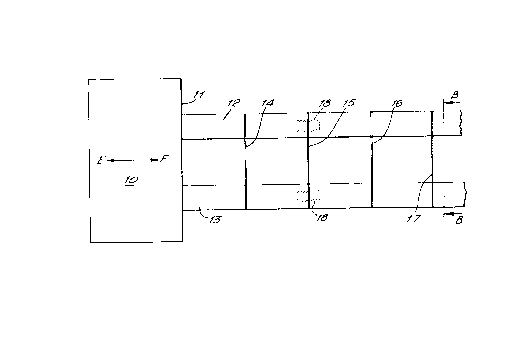Some of the information on this Web page has been provided by external sources. The Government of Canada is not responsible for the accuracy, reliability or currency of the information supplied by external sources. Users wishing to rely upon this information should consult directly with the source of the information. Content provided by external sources is not subject to official languages, privacy and accessibility requirements.
Any discrepancies in the text and image of the Claims and Abstract are due to differing posting times. Text of the Claims and Abstract are posted:
| (12) Patent: | (11) CA 2053722 |
|---|---|
| (54) English Title: | CUTTING DEVICE |
| (54) French Title: | DISPOSITIF DE COUPE |
| Status: | Expired and beyond the Period of Reversal |
| (51) International Patent Classification (IPC): |
|
|---|---|
| (72) Inventors : |
|
| (73) Owners : |
|
| (71) Applicants : |
|
| (74) Agent: | BORDEN LADNER GERVAIS LLP |
| (74) Associate agent: | |
| (45) Issued: | 2000-05-23 |
| (22) Filed Date: | 1991-10-18 |
| (41) Open to Public Inspection: | 1992-04-20 |
| Examination requested: | 1998-05-01 |
| Availability of licence: | N/A |
| Dedicated to the Public: | N/A |
| (25) Language of filing: | English |
| Patent Cooperation Treaty (PCT): | No |
|---|
| (30) Application Priority Data: | ||||||
|---|---|---|---|---|---|---|
|
1. A cutting device comprising an ultrasonic vibrating
device and a cutting blade mounted on the device so as
to be vibrated thereby/therewith, the blade lying in a
plane extending transversely to the longitudinal axis of
vibration wherein the vibrating device comprises two or
more support members, the cutting blade being supported
by two adjacent support members.
Note: Claims are shown in the official language in which they were submitted.
Note: Descriptions are shown in the official language in which they were submitted.

2024-08-01:As part of the Next Generation Patents (NGP) transition, the Canadian Patents Database (CPD) now contains a more detailed Event History, which replicates the Event Log of our new back-office solution.
Please note that "Inactive:" events refers to events no longer in use in our new back-office solution.
For a clearer understanding of the status of the application/patent presented on this page, the site Disclaimer , as well as the definitions for Patent , Event History , Maintenance Fee and Payment History should be consulted.
| Description | Date |
|---|---|
| Time Limit for Reversal Expired | 2007-10-18 |
| Letter Sent | 2006-10-18 |
| Inactive: IPC from MCD | 2006-03-11 |
| Grant by Issuance | 2000-05-23 |
| Inactive: Cover page published | 2000-05-22 |
| Inactive: Final fee received | 2000-02-22 |
| Pre-grant | 2000-02-22 |
| Notice of Allowance is Issued | 1999-08-30 |
| Notice of Allowance is Issued | 1999-08-30 |
| Letter Sent | 1999-08-30 |
| Inactive: Approved for allowance (AFA) | 1999-08-12 |
| Amendment Received - Voluntary Amendment | 1999-07-14 |
| Amendment Received - Voluntary Amendment | 1999-04-28 |
| Letter Sent | 1998-05-29 |
| Inactive: Application prosecuted on TS as of Log entry date | 1998-05-28 |
| Inactive: Status info is complete as of Log entry date | 1998-05-28 |
| Request for Examination Requirements Determined Compliant | 1998-05-01 |
| All Requirements for Examination Determined Compliant | 1998-05-01 |
| Application Published (Open to Public Inspection) | 1992-04-20 |
There is no abandonment history.
The last payment was received on 1999-09-17
Note : If the full payment has not been received on or before the date indicated, a further fee may be required which may be one of the following
Please refer to the CIPO Patent Fees web page to see all current fee amounts.
| Fee Type | Anniversary Year | Due Date | Paid Date |
|---|---|---|---|
| MF (application, 6th anniv.) - standard | 06 | 1997-10-20 | 1997-09-22 |
| Request for examination - standard | 1998-05-01 | ||
| MF (application, 7th anniv.) - standard | 07 | 1998-10-19 | 1998-09-17 |
| MF (application, 8th anniv.) - standard | 08 | 1999-10-18 | 1999-09-17 |
| Final fee - standard | 2000-02-22 | ||
| MF (patent, 9th anniv.) - standard | 2000-10-18 | 2000-09-19 | |
| MF (patent, 10th anniv.) - standard | 2001-10-18 | 2001-09-18 | |
| MF (patent, 11th anniv.) - standard | 2002-10-18 | 2002-09-19 | |
| MF (patent, 12th anniv.) - standard | 2003-10-20 | 2003-09-17 | |
| MF (patent, 13th anniv.) - standard | 2004-10-18 | 2004-09-09 | |
| MF (patent, 14th anniv.) - standard | 2005-10-18 | 2005-10-14 |
Note: Records showing the ownership history in alphabetical order.
| Current Owners on Record |
|---|
| SOCIETE DES PRODUITS NESTLE S.A. |
| Past Owners on Record |
|---|
| FRANCIS FREDERICK HAMILTON RAWSON |
| MARTIN HARROP |